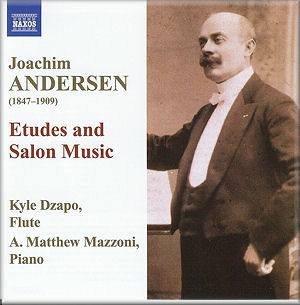 |
 |
|


alternatively
CD: MDT
AmazonUK
AmazonUS
Sound
Samples & Downloads |
Etudes and Salon Music
Cesare CIARDI (1818-1877)
Le Carnaval Russe (with cadenzas by Andersen) [7:54]
Isidor DANNSTROM (1812-1897)
Schwedische Polska-Lieder, Op. 50, transcribed by Andersen [8:45]
Joachim ANDERSEN (1847-1909)
Acht Vortragesstücke, Op. 55 No. 4 Die Mühle [3:21]; No. 5 Legende
[6:14]; No. 8 Tarantella [2:00]; 24 Grosse Etüden, Op. 15 No. 3
in G major [2:20]; No. 24 in D minor [6:31]; Opern-Transcriptionen,
Op. 45, No. 5 Fantasy on Don Giovanni [6:16]; Deuxième morceau de
concert, Op. 61 [10:22]
 Kyle Dzapo (flute); A. Matthew Mazzoni (piano)
Kyle Dzapo (flute); A. Matthew Mazzoni (piano)
rec. 18-20 August 2007, The Recital Hall, The Performing Arts Center,
Purchase College, Purchase NY. DDD
 NAXOS 8.572277 [54:12]
NAXOS 8.572277 [54:12] 
|
|
|
This disc comprises Etudes and Salon works by Danish Composer
and flute player, Joachim Andersen. Andersen was known primarily
for his compositions for flute, and also as a founder member
of the Berlin Philharmonic
The opening work is Cesare Ciardi’s Le Carnaval Russe,
a work which Andersen performed at the inaugural concert of
the Berlin Philharmonic, and for which he composed the cadenzas.
The piece is a set of variations on an operatic theme by Alexander
Serov. This is a typical example of salon music of the time,
with a popular melody by one composer subjected to virtuoso
treatment by another and then with elaborate cadenzas added
by the performer. Kyle Dzapo’s flute playing here is clean and
precise, with excellent technical control which makes up for
a lack of dramatic flamboyance.
Andersen was also known for his transcriptions for flute and
piano. Next on the disc are two of Dannström’s Swedish Polka
Songs, heard in transcription. These are charming works
which are full of character and are given a light and sparkling
performance here.
The Acht Vortragesstücke (8 Performance Pieces) are a
set of miniatures which are similarly full of charm and energy.
Die Mühle (The Mill) is a bustling work which is played
here with excellent technical evenness, while Dzapo and Mazzoni
present Legende with a sense of romantic expression and
warmth. The set of eight pieces - of which three are heard here
- concludes with the light and dance-like Tarantella,
which is characterized here with clear articulation and a good
sense of flow.
Most flute players first encounter Andersen’s music through
his etudes, and the Op. 15 set are perhaps the most celebrated,
with both musical and technical challenges. Dzapo performs numbers
3 and 24 here, with impressively smooth lines and a good sense
of phrasing.
Andersen’s opera transcriptions are also an important part of
his compositional output. Included on this disc is the Fantasy
on Don Giovanni. This is an entertaining arrangement which begins
with the usual Andersen flair, but quickly relaxes into Mozart’s
lyrical lines. There is contrast between the arias, and a sense
of humour in the arrangement which brings lightness and entertainment,
all of which is captured very well by these players.
The final work on the disc is the ebullient Deuxième morceau
de concert, a virtuoso piece which begins with a display
of energy. The music gradually calms down and includes some
gentle lyrical lines which allow space for imaginative phrasing
and the demonstration of a good, sonorous tone. A darker piano
interlude follows, before a turbulent section with fast-moving
lines and rapid changes of harmony. The ending is suitably dramatic,
demonstrating both virtuoso skill and performance bravura.
Overall this is an enjoyable disc of light-hearted repertoire,
performed with good technical control, a lovely flute sound
and a well-judged piano accompaniment. Worth hearing.
Carla Rees
|
|

